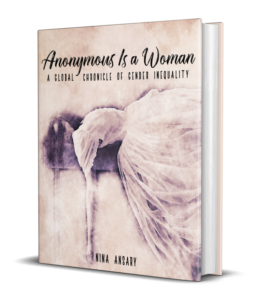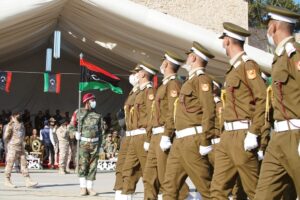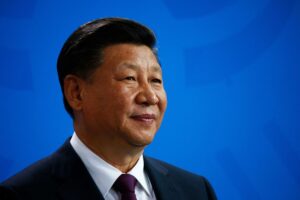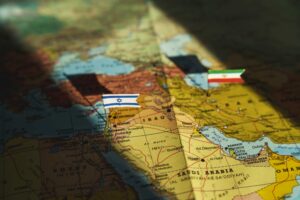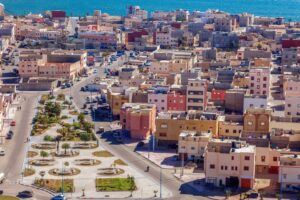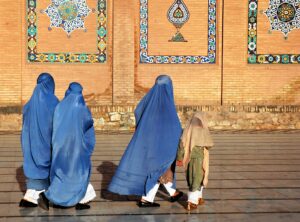After 9/11, Muslims around the world watched warily as the U.S. launched the “Global War on Terror” abroad and passed the Patriot Act at home, with its consequent surveillance of the American Muslim community. The fact that the U.S. military response started with the invasion of Afghanistan but then pivoted to Iraq, a country that had nothing to do with the 9/11 attacks, made it clear that the U.S. juggernaut might take aim at any Muslim-majority country and that the American public would do little prevent it.
The use of “democracy promotion” as a justification for the occupation of Iraq was particularly troubling for the many non-democratic rulers dominating the Middle East. Bush’s notion that Iraq would be the first domino to fall in a chain reaction of democratic transitions made these rulers nervous.[i] Rulers were well aware of public dissatisfaction with the rampant corruption and lack of opportunities for economic or political engagement that characterized life for the majority of their citizens. The Bush administration had correctly identified democracy and good governance as important ingredients in efforts to prevent violent extremism. Arab rulers were eager to deflect attention from the ways in which their reliance on repression fostered disaffection and sometimes violence. For this reason, “radical Islam” became a useful scapegoat that reduced the risk that the U.S. might pressure rulers to democratize or address other systemic failures.
Arab rulers portrayed themselves as the only alternative to Islamists, knowing that most non-Muslim publics lacked the nuance or inclination to discern between an “Islamist” and a “terrorist.”
Characterizing Islam as the primary driver of violence, specifically the “wrong” interpretation of Islam, served a second purpose: rulers could paint Islamist political opposition groups as driving violent extremism. As a result, crackdowns on Islamist groups could be characterized as “countering terrorism.” Simultaneously, rulers could portray their own preferred interpretation of Islam, or “moderate Islam,” as preventing violence, thereby garnering international support for their continued rule. Arab rulers portrayed themselves as the only alternative to Islamists, knowing that most non-Muslim publics lacked the nuance or inclination to discern between an “Islamist” and a “terrorist.” (To clarify, in my usage, the term “Islamist” refers to an individual or organization that advocates for a greater role for Islam in public life.)
Despite an initial focus on democracy promotion, the Bush administration did little to combat the role of Islamophobia in linking terrorism with Islam and Islamist movements. As early as January 2003, American commentators acknowledged that democracy promotion might empower “anti-American elements,” by which they meant Islamist groups.[ii] This occurred in 2006, when Hamas won parliamentary elections in Gaza, an outcome the U.S. scrambled to reject on the basis of Hamas’ status as a “terrorist organization.” The U.S. then tried to provoke a civil war between Fatah and Hamas in an effort co-ordinated by Secretary of State Condoleezza Rice and Elliott Abrams, nicknamed “Iran Contra 2.0”. The initiative ultimately backfired and resulted in Hamas securing total control of Gaza.[iii] Democracy promotion in the Middle East was looking less attractive to the Bush team, especially as it became clear that the U.S. occupation of Iraq would not magically transform the country into a functioning democracy.
The narrative that terrorism resulted from misinterpretations of Islam, rather than the structural factors that drove some individuals to violence, benefitted American administrations as well as ruling Arab governments, as it allowed them to maintain their mutually beneficial relationships. In 2007, the RAND corporation suggested the need to “build moderate Muslim networks.”[iv] The fact that the RAND report was praised by Daniel Pipes, whom the Southern Poverty Law Center later identified in their “Field Guide to Anti-Muslim Extremists,” should convey a sense of the flaws inherent in the concept.[v] Yet, the focus on so-called moderate Muslims offered inherent utility as a means of avoiding thornier issues: namely, how the violence of autocracy combined with American military hegemony fostered violent resistance.
Arab governments encouraged “moderate Islam,” whose lack of a clear definition allowed it to be repurposed in multiple forms. An early mover to try to take up the mantle of moderate Islam was Jordan: in 2004, King Abdullah II convened Muslim scholars from around the world to produce the “Amman Message,” which highlighted the tenets of Islam shared by all Muslims in an effort to reduce declarations of apostasy (takfir), a tactic frequently used by extremists to justify violence against other Muslims.[vi] Jordan also issued “A Common Word” in 2007, which emphasized similarities between Islam and Christianity, and successfully established “Interfaith Harmony Week” in 2010, observed each year in partnership with the United Nations. As wittily described by Stacey Gutkowski, Jordan portrayed itself as “the very model of a moderate Muslim state.”[vii]
Simultaneously, Jordan’s King Abdullah progressively marginalized the Jordanian Muslim Brotherhood, a group previously known for its “loyal opposition” to Hashemite rule.[viii] Unlike their counterparts in Egypt, the Jordanian Muslim Brothers had historically been spared the harshest forms of state persecution and, in turn, kept their demands and critiques relatively mild. However, the relationship between the Brothers and the Hashemites changed over time: a professor at the University of Jordan in Amman explained to me that under King Hussein, the Muslim Brotherhood fit under the definition of “moderate Islam,” but under King Abdullah, they did not: it was up to the ruler to define what “moderate” meant. King Abdullah’s government increasingly targeted the Jordanian Muslim Brotherhood and at the end of 2020 declared it “officially dissolved,” despite the group’s protests to the contrary.[ix]
“Moderate Islam” as a public relations strategy became more prominent after 9/11, while the uprisings of 2011 reinforced the perceived threat posed by Islamists.
The use of “moderate Islam” as a public relations strategy became more prominent after 9/11, while the uprisings of 2011 reinforced the perceived threat posed by Islamists. As a result, the definition of “moderate” shifted: for example, the Muslim Brotherhood had previously been considered “moderate” because they repudiated violence, yet after 2011 many governments feared their manifest ability to win power, as demonstrated in Tunisia and Egypt, and designated them a terrorist organization.[x] Meanwhile, more governments began to adopt the language of moderate Islam as an alleged means of preventing violent extremism, including Egypt, Morocco, the UAE, and eventually even Saudi Arabia.[xi]
As violence escalated in the aftermath of the uprisings, some governments escalated the rhetoric that they represented the only alternative to terrorists. Bashar al-Assad for example, portrayed his secular Baathist government as a desirable “moderate” alternative to the rebels he sought to quell, who his government described as “terrorists.”[xii] The brutality of the Assad government’s assaults on its own citizens did not prevent some commentators from viewing his rule as preferable to that of an Islamist takeover.[xiii] The persistent lack of nuanced understanding of the dynamics on the ground in Syria contributed to fears that the U.S. was supporting “extremists.”
The increasing competition to speak for moderate Islam in the region resulted in part from a rise in U.S. demand for interlocutors: 2009 witnessed the emergence of “a veritable cottage industry of Muslim engagement activities in U.S. foreign policy.”[xiv] The Obama administration had come to power determined to improve America’s image in the Middle East, manifested in Obama’s famous Cairo speech in June 2009. Obama’s team emphasized the imperative to develop more robust relations with religious communities beyond an existing White House office established by the Bush administration.[xv] Obama focused on outreach to Muslims, such as by appointing Farah Pandith to serve as the State Department’s special representative for Muslim communities.
Yet, such efforts sometimes had unintended effects. For example, they tended to reify the authority of formal religious institutions and actors. This reinforced the power of individuals who typically represented codified religious doctrine—who tended to be older and overwhelmingly male—rather than the individuals pushing the boundaries of religious belief, who were more likely to include people who were younger, potentially female, and more marginalized. When interacting with Muslim religious leaders, assumptions about clerical hierarchies more familiar to some Christians, such as the structure of the Catholic, Anglican, or Orthodox churches, sometimes obscured the more horizontal structures that characterize religious leadership in Sunni Islam, Judaism, and some Protestant sects.
The pitfalls of this approach became apparent in Obama’s second term, after the turbulence of the Arab uprisings in 2011 eventually resulted in the rise of the Islamic State in Iraq and Syria (ISIS) in 2014. The group claimed to represent the reincarnation of the Prophet Mohamed’s caliphate in its adherence to the most “authentic” interpretation of Islamic law, a notion of authenticity grounded in decades of Saudi propaganda that intolerance corresponded to the most orthodox form of Islam. The group’s declarations to have established a true Islamic state appealed to many, especially the young and marginalized, and thousands traveled to join them. The sometimes geriatric members of the formal religious establishment had few tools to compete with a social media savvy group of young and savage zealots.
Nevertheless, governments in the Middle East, Europe, and North America scrambled to find a means of repudiating the group. Certain figures came forward, or were brought forward, as the clerics who could “solve ISIS.”[xvi] Governments earned additional plaudits for setting up centers dedicated to countering violent extremism or holding conferences of Muslim religious scholars to repudiate ISIS. The Moroccan government, for example, did both, establishing the Mohammed VI Institute in 2015 to train clerics in Morocco’s version of moderate Islam and, in 2016, convening clerics to issue the “Marrakesh Declaration” to condemn ISIS’ treatment of the Yazidi minority in Iraq.[xvii] Yet, such initiatives had minimal success in reducing the appeal of ISIS, which was defeated militarily but whose ideology remains a source of concern.
Under Trump, the pendulum of American policy swung dramatically in the direction of officially sanctioned Islamophobia with policies like the “Muslim Ban.” Trump’s presidency witnessed Saudi Arabia’s powerful crown prince, Mohammed bin Salman attempt to portray his efforts as “returning to moderate Islam,” a claim that American commentators such as New York Times columnist Thomas Friedman[xviii] initially bought into until the brutal murder of Washington Post contributor and U.S. resident Jamal Khashoggi.[xix] Trump’s candidacy and presidency demonstrated that many Americans still feared Islam, a fear that the Obama administration had unfortunately done little to counteract.
The new Biden administration does not appear to possess the same appetite for outreach to the Muslim community, which may in fact be preferable to the sometimes unintended consequences of Obama-era policies.
Thus far, the new Biden administration does not appear to possess the same appetite for outreach to the Muslim community, which may in fact be preferable to the sometimes unintended consequences of Obama-era policies. But in general, the U.S. continues to arm despotic governments while largely ignoring their abuses of their own citizens, content with the fiction that stable autocracy is preferable to the chaos witnessed in the aftermath of 2011. The U.S. retains its status as military hegemon in the region, despite numerous assertions that the U.S. ought “to pivot to Asia” in order to focus on China.
Since 9/11, the decision to blame acts of political violence committed by Muslims on their faith, specifically on an alleged misinterpretation of Islam that could be corrected by a “moderate” interpretation of Islam, has had the effect of reinforcing the appearance that the War on Terror was in fact a war on Islam, which has exacerbated the threat of violent extremism committed by Muslims. Twenty years after 9/11, insufficient efforts have been made to educate Americans about Islam, such that efforts to link violence with Islam would appear as preposterous as to claim such a link with Christianity.
Rulers continue to benefit from international fears of Islam, use it to repress Islamist groups, and face minimal external censure for doing so. If they targeted another category of dissidents in a similar manner, they would likely arouse more concerns about human rights violations. However, as the U.S. continues to demonstrate with the ongoing presence of detainees in Guantanamo Bay, individuals classified as “terrorists” do not merit the same legal and moral protections as other individuals.
[i] Editorial staff, “Bush’s Domino Theory,” Christian Science Monitor, January 28, 2003. https://www.csmonitor.com/2003/0128/p08s02-comv.html
[ii] Greg Miller, “Democracy Domino Theory ’Not Credible’,” Los Angeles Times, March 14, 2003. https://www.latimes.com/archives/la-xpm-2003-mar-14-fg-domino14-story.html
[iii] David Rose, “The Gaza Bombshell,” Vanity Fair, March 3, 2008. https://www.vanityfair.com/news/2008/04/gaza200804
[iv] Angel Rabasa, Cheryl Benard, Lowell H. Schwartz and Peter Sickle. Building Moderate Muslim Networks. Santa Monica, CA: RAND Corporation, 2007. https://www.rand.org/pubs/monographs/MG574.html
[v] Brennan Suen, “Media Matters and Civil Rights Groups Release Media ‘Field Guide To Anti-Muslim Extremists’,” Media Matters for America, October 27, 2016.
https://www.mediamatters.org/pamela-geller/media-matters-and-civil-rights-groups-release-media-field-guide-anti-muslim
[vi] https://ammanmessage.com/
[vii] Stacey Gutkowski, “We are the Very Model of a Moderate Muslim State: The Amman Message and Jordan’s Foreign Policy,” International Relations Vol 30, No. 2 (2015): 206-226. https://journals.sagepub.com/doi/abs/10.1177/0047117815598352
[viii] Nur Köprülü, “Is Jordan’s Muslim Brotherhood Still the Loyal Opposition?” Middle East Quarterly, Vol. 24 Issue 2 (2017): 1-9. https://www.meforum.org/6560/is-jordan-muslim-brotherhood-still-the-loyal
[ix] “Jordan revisits relationship with Muslim Brotherhood” https://www.al-monitor.com/pulse/originals/2021/01/jordan-muslim-brotherhood-dissolve-crackdown-relations.html
[x] Annelle Sheline, “Shifting Reputations for “Moderation”: Evidence from Qatar, Jordan, and Morocco.” Vol 12, No 1 (2020): 109-129. https://brill.com/view/journals/melg/12/1/article-p109_109.xml
[xi] Annelle Sheline, “Middle East Regimes Are Using ‘Moderate Islam’ to stay in Power,” The Washington Post – Monkey Cage blog, March 1, 2017. https://www.washingtonpost.com/news/monkey-cage/wp/2017/03/01/middle-east-regimes-are-using-moderate-islam-to-stay-in-power/
[xii] “Syria FM: Our battle against terrorism ‘almost over’,” Al Jazeera, September 29, 2018. https://www.aljazeera.com/news/2018/9/29/syria-fm-our-battle-against-terrorism-almost-over
[xiii] See, e.g., Cyrus Malik, “Washington’s Sunni Myth and the Middle East Undone,” War on the Rocks, August 23, 2016. https://warontherocks.com/2016/08/washingtons-sunni-myth-and-the-middle-east-undone/
[xiv] Peter Mandaville, “Why the Biden Administration Should Stay Out of the Global ‘Muslim Engagement’ Business,” The Brookings Institution, December 14, 2020.
https://www.brookings.edu/blog/order-from-chaos/2020/12/14/why-the-biden-administration-should-stay-out-of-the-global-muslim-engagement-business/
[xv] https://georgewbush-whitehouse.archives.gov/government/fbci/president-initiative.html
[xvi] Peter Mandaville and Melissa Nozell, “Engaging Religion and Religious Actors in Countering Violent Extremism,” The United States Institute of Peace, August 2017. https://www.usip.org/publications/2017/08/engaging-religion-and-religious-actors-countering-violent-extremism
[xvii] King Mohammed VI Inaugurates International Imam Training Center in Rabat in Push to Promote Moderate Islam https://www.globenewswire.com/news-release/2015/03/27/1306539/0/en/King-Mohammed-VI-Inaugurates-International-Imam-Training-Center-in-Rabat-in-Push-to-Promote-Moderate-Islam.html
The Marrakesh Declaration http://www.marrakeshdeclaration.org/declaration/
[xviii] Thomas Friedman, “Saudi Arabia’s Arab Spring, at Last,” The New York Times, 2017. https://www.nytimes.com/2017/11/23/opinion/saudi-prince-mbs-arab-spring.html
[xix] Martin Chulov, “’I will return Saudi Arabia to moderate Islam’ says Crown Prince,” The Guardian, 2017. https://www.theguardian.com/world/2017/oct/24/i-will-return-saudi-arabia-moderate-islam-crown-prince



